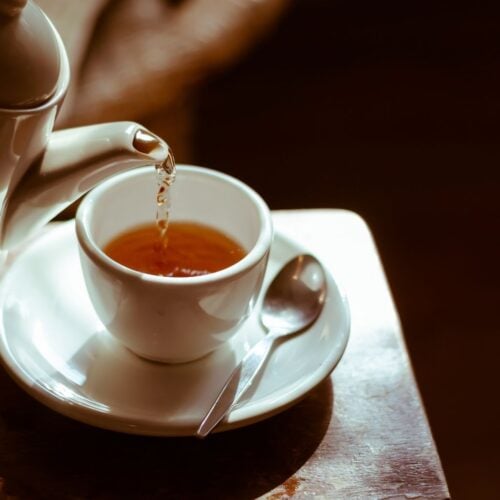The Outdoor Apothecary is reader-supported. When you buy through links on our site, we may earn an affiliate commission. Learn more

Blue vervain tea has been cherished for centuries for its calming properties, especially appreciated by those who experience both nervous tension and digestive discomfort. It’s intriguing how our minds and bodies are interconnected—feeling anxious can lead to an upset stomach and a racing heart. A cup of blue vervain tea can offer a gentle way to unwind and bring a sense of calm to the entire system.
As someone who often feels on edge, I frequently turn to herbal teas for support. Blue vervain is one of my favorites for these moments. When I’m feeling a bit anxious or need something to help me navigate those uneasy feelings, I brew a cup of vervain tea. It’s not an instant solution, but it helps me feel more balanced. I also enjoy adding it to my nighttime tea blends for an extra touch of relaxation.
What is Blue Vervain?
Blue vervain (Verbena hastata), also called simpler’s joy and enchanter’s plant is an herb native to North America and is closely related to vervain (V. officinalis). It can grow up to 5 feet in height and produces small blue flowers. In the wild, it is most often found in disturbed areas, moist prairies and meadows, around springs and stream banks, and in low, open woodlands.
Blue vervain has been used for centuries for its medicinal properties. Native Americans used blue vervain to treat snake bites, colds, fevers, and more. In fact, Native American tribes called blue vervain “herb of grace” because it was thought to promote peace and calm. The plant was also used in various ceremonies and rituals. Today, vervain continues to be used for emotional and psychological well-being, especially for conditions relating to anxiety and feeling overwhelmed. It is nervine, meaning that it nourishes the nervous system when taken over extended periods of time
What Parts are Used for Vervain Tea?
The aerial parts of the plant (leaves and flowers) can be dried and used to make vervain tea. You can buy the aerial parts from an herb store or grow your own and make your own herbal vervain tea.

How Does Blue Vervain Work?
Vervain has long been valued by herbalists for its ability to support emotional balance and calmness. This herb is known for its relaxing and uplifting properties, often used to enhance mood and promote a sense of well-being. Many people find that vervain helps them achieve a restful night’s sleep without feeling groggy the next day.
Research suggests that vervain can influence levels of GABA, a neurotransmitter that plays a role in reducing anxiety. Blue vervain, in particular, interacts with the same receptors in the brain as GABA, promoting a calming effect that can help clear the mind and reduce feelings of anxiety.
Where to Find Blue Vervain
Information can be found for safely identifying and foraging blue vervain in this article titled: Blue Vervain: The Hidden Aspects Of A Magical Medicinal Herb
If you can’t find the herbs you need locally, you can purchase them from Mountain Rose Herbs. My favorite place to buy high-quality, organic dried herbs and herbal products.
When Not to Take Blue Vervain
Vervain is thought to be safe to use, but it should not be taken in large doses. It is not recommended for use during pregnancy because it can stimulate the uterus, and it should not be used with blood pressure medications or hormone therapy. Large doses may cause diarrhea or vomiting.

Vervain Tea
Barbi GardinerEquipment
- Heat proof jar
- Tea strainer
- Favorite mug
Ingredients
- Dried vervain
Instructions
- Add 1-3 teaspoons of the dried herb to a heat-proof jar
- Pour 8-10 oz. of hot water over them.
- Cover the jar and let your tea steep for at least 15 minutes.
- Strain out the herbs
Notes
As an Amazon Associate, I earn from qualifying purchases.
Disclaimer:
The Outdoor Apothecary website is intended for informational purposes only and should not be considered a substitute for professional medical advice. The information provided is not intended to diagnose, treat, cure, or prevent any disease. While we strive to provide accurate and up-to-date information, it is the reader’s responsibility to ensure proper plant identification and usage.
Please be aware that some plants are poisonous or can have serious adverse health effects. We are not health professionals, medical doctors, or nutritionists. It is essential to consult with qualified professionals for verification of nutritional information, health benefits, and any potential risks associated with edible and medicinal plants mentioned on this website.

Do you have a link to any info of why not to use blue vervain with hormone therapy? I use some natural supplements. It sure helps my sleep!
Thanks so much for your question! While I’m not a clinical herbalist and can’t offer medical advice, I do recommend checking in with one—especially if you’re using hormone therapy. From what I’ve read, blue vervain may potentially interfere with hormonal treatments, as it’s thought to have effects on the endocrine system. It’s always best to consult a qualified practitioner who can look at your full picture and help you stay safe while getting the most benefit from your herbs and supplements.